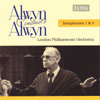Alwyn Symphonies Nos 1 and 4
View record and artist detailsRecord and Artist Details
Composer or Director: William Alwyn
Genre:
Orchestral
Label: Lyrita
Magazine Review Date: 7/1992
Media Format: CD or Download
Media Runtime: 77
Mastering:
Stereo
ADD
Catalogue Number: SRCD227

Tracks:
| Composition | Artist Credit |
|---|---|
| Symphony No. 1 |
William Alwyn, Composer
London Philharmonic Orchestra William Alwyn, Conductor William Alwyn, Composer |
| Symphony No. 4 |
William Alwyn, Composer
London Philharmonic Orchestra William Alwyn, Composer William Alwyn, Conductor |
Composer or Director: William Alwyn
Label: Chandos
Magazine Review Date: 7/1992
Media Format: CD or Download
Media Runtime: 65
Mastering:
DDD
Catalogue Number: CHAN8902

Tracks:
| Composition | Artist Credit |
|---|---|
| Symphony No. 4 |
William Alwyn, Composer
London Symphony Orchestra Richard Hickox, Conductor William Alwyn, Composer |
| Elizabethan Dances |
William Alwyn, Composer
London Symphony Orchestra Richard Hickox, Conductor William Alwyn, Composer |
| Festival March |
William Alwyn, Composer
London Symphony Orchestra Richard Hickox, Conductor William Alwyn, Composer |
Author: Ivan March
The two accounts are remarkably alike, even though in the first movement the composer's timing is a minute and a half shorter than Hickox's, and in the finale he saves a minute and a quarter, Hickox's extra spaciousness does not mean that either the tension or the momentum flags. Indeed, when one compares his phrasing of the long and beautiful string cantilena which opens the Adagio e molto calmato of the Passacaglia finale, its ebb and flow and dynamic gradations suggest either that Hickox has listened to the composer's LP or has a remarkable, instinctive feeling for the music (probably both).
At the opening of the first movement a horn melisma soon appears, which the LSO principal plays with a touch more intensity at its climax, and later (8'57'') Hickox accents the string theme more forcefully than the composer, elsewhere the LPO brass snarls and bites more readily under Alwyn. This is not to say that the big, almost Stravinskian climax which comes about six minutes or so into the work (Chandos timing) is not stridently powerful in the hands of Hickox and the LSO. The scherzo too may have a bit more bite with Alwyn (as do the curiously plangent woodwind squawks at 7'22'' of the opening movement of the Lyrita disc), but this is at least partly caused by the more leonine Lyrita sound. The centrepiece of the scherzo brings a glorious blossoming from the violins which is equally thrilling in both performances, while at the very end of the symphony the final brass peroration has great forceful thrust from the composer. However, with the LSO and Hickox the slightly richer, more spacious Chandos recording adds to the weight of sonority. In short, these are both highly compelling performances of a remarkably diverse and well-argued symphony, bursting with lyrical ideas and melodic in the way traditional music is communicative, without being old-fashioned. So now let us consider couplings.
Those on Chandos are relatively slight. The Elizabethan Dances aren't very early Elizabethan but the languid ''Waltz'' (No. 2) is rather charming and the ''Poco Allegretto'' (No. 5) is even more so; the vigorous numbers are more conventional. The Festival March, written for the 1951 Festival of Britain, is an agreeable occasional piece, although its big tune isn't as memorable of those of Walton or Elgar. Yet if you want a modern digital recording of the Fourth Symphony, these are acceptable makeweights. On the other hand, Lyrita offer the Symphony No. 1. It is a work teeming with ideas, and quite often reminds one of Alwyn's film music (which is not meant to be a pejorative remark). With its ample scoring the composer does go over the top a bit at times and this is not nearly so cogently argued a piece as the Fourth, although it has a rather appealing
Discover the world's largest classical music catalogue with Presto Music.

Gramophone Digital Club
- Digital Edition
- Digital Archive
- Reviews Database
- Full website access
From £8.75 / month
Subscribe
Gramophone Full Club
- Print Edition
- Digital Edition
- Digital Archive
- Reviews Database
- Full website access
From £11.00 / month
Subscribe
If you are a library, university or other organisation that would be interested in an institutional subscription to Gramophone please click here for further information.





